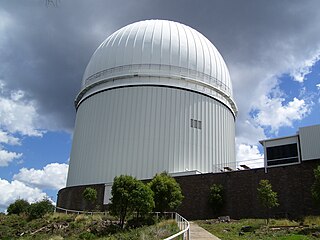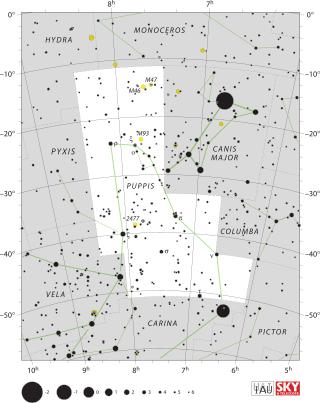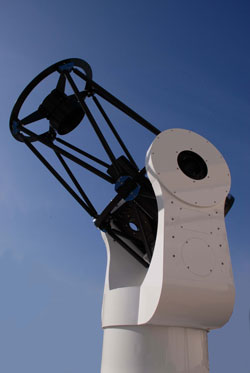Related Research Articles

The Australian Astronomical Observatory (AAO), formerly the Anglo-Australian Observatory, was an optical and near-infrared astronomy observatory with its headquarters in North Ryde in suburban Sydney, Australia. Originally funded jointly by the United Kingdom and Australian governments, it was managed wholly by Australia's Department of Industry, Innovation, Science, Research and Tertiary Education. The AAO operated the 3.9-metre Anglo-Australian Telescope (AAT) and 1.2-metre UK Schmidt Telescope (UKST) at Siding Spring Observatory, located near the town of Coonabarabran, Australia.

The Anglo-Australian Telescope (AAT) is a 3.9-metre equatorially mounted telescope operated by the Australian Astronomical Observatory and situated at the Siding Spring Observatory, Australia, at an altitude of a little over 1,100 m. In 2009, the telescope was ranked as having the fifth-highest-impact of the world's optical telescopes. In 2001–2003, it was considered the most scientifically productive 4-metre-class optical telescope in the world based on scientific publications using data from the telescope.

Robert Paul Butler is an astronomer and staff scientist at the Carnegie Institution for Science in Washington, D.C., who searches for extrasolar planets.

The High Accuracy Radial Velocity Planet Searcher (HARPS) is a high-precision echelle planet-finding spectrograph installed in 2002 on the ESO's 3.6m telescope at La Silla Observatory in Chile. The first light was achieved in February 2003. HARPS has discovered over 130 exoplanets to date, with the first one in 2004, making it the most successful planet finder behind the Kepler space observatory. It is a second-generation radial-velocity spectrograph, based on experience with the ELODIE and CORALIE instruments.
HD 102117 or Uklun is a star in the southern constellation of Centaurus. With an apparent visual magnitude of 7.47, it is too dim to be seen without binoculars or a small telescope. It is located at a distance of approximately 129 light years from the Sun based on parallax. HD 102117 is drifting further away with a radial velocity of +50 km/s, having come to within 43.9 light-years some 692,000 years ago. It has one known planet.
HD 179949 is a 6th magnitude star in the constellation of Sagittarius. It is a yellow-white dwarf, a type of star hotter and more luminous than the Sun. The star is located about 90 light years from Earth and might be visible under exceptionally good conditions to an experienced observer without technical aid; usually binoculars are needed.

Nu Phoenicis is a F-type main-sequence star in the southern constellation of Phoenix. It is visible to the naked eye with an apparent visual magnitude of 4.95. This is a solar analogue, meaning its observed properties appear similar to the Sun, although it is somewhat more massive. At an estimated distance of around 49.5 light years, this star is located relatively near the Sun.

Doppler spectroscopy is an indirect method for finding extrasolar planets and brown dwarfs from radial-velocity measurements via observation of Doppler shifts in the spectrum of the planet's parent star. As of November 2022, about 19.5% of known extrasolar planets have been discovered using Doppler spectroscopy.
Gliese 86 is a K-type main-sequence star approximately 35 light-years away in the constellation of Eridanus. It has been confirmed that a white dwarf orbits the primary star. In 1998 the European Southern Observatory announced that an extrasolar planet was orbiting the star.
HD 164427 is a star with a brown dwarf companion in the southern constellation of Pavo. It has an apparent visual magnitude of 6.88, placing it just below the nominal limit for visibility with the typical naked eye. The annual parallax shift of 23.5 mas yields a distance estimate of 42.6 light years. It is moving further from the Earth with a heliocentric radial velocity of +3.4 km/s.
HD 154672 b is an extrasolar planet located approximately 210 light-years away in the constellation of Ara, orbiting the metal-rich and aged star HD 154672. This planet has a minimum mass five times that of Jupiter and orbits at about 60% the distance between the Earth to the Sun. Its orbit is very elliptical, which causes temperatures on the planet to vary significantly as it proceeds along its orbit. This planet was discovered in Las Campanas Observatory on September 5, 2008 using the radial velocity method. Along with HD 205739 b, the planets were the first to be discovered by the N2K Consortium using the Magellan Telescopes.
HD 204313 b is an extrasolar planet which orbits the G-type main sequence star HD 204313, located approximately 155 light years away in the constellation Capricorn. This planet orbits the star at a distance of 3.082 astronomical units and takes 1931 days or 5.29 years to revolve around the star. It has a minimum mass four times that of Jupiter. However the radius is not known since this planet was not detected by the transit method or direct imaging. Instead, this planet was detected by the radial velocity method using the CORALIE Echelle spectrograph mounted on the 1.2 meter Euler Swiss Telescope located at La Silla Observatory in Atacama desert, Chile on August 11, 2009.

The Magellan Planet Search Program is a ground-based search for extrasolar planets that makes use of the radial velocity method. It began gathering data in December 2002 using the MIKE echelle spectrograph mounted on the 6.5m Magellan II "Clay" telescope located within the Las Campanas Observatory in Chile. In 2010, the program began using the newly commissioned Planet Finder Spectrograph (PFS), an instrument purpose-built for precise radial velocity measurement.

ESPRESSO is a third-generation, fiber fed, cross-dispersed, echelle spectrograph mounted on the European Southern Observatory's Very Large Telescope (VLT). The unit saw its first light on September 25, 2016.
The Fiber-Optic Improved Next-Generation Doppler Search for Exo-Earths is a radial-velocity spectrograph developed by Debra Fischer. It is installed on the 3 meter telescope in Lick Observatory in Mount Hamilton. It has been in operation since 2009 and is being used to verify exoplanet candidates found by Kepler.

HD 114613 is a fifth magnitude yellow subgiant that lies 66.7 light-years away in the constellation of Centaurus. The star may be host to a long-period giant planet.
HD 219077 is a faint, yellow-hued star in the southern constellation of Tucana. It has an apparent visual magnitude of +6.12, which is near the lower limit on stars visible to the naked eye. Based upon an annual parallax shift of 34.25 mas as seen from Earth, it lies 95 light years from the Sun. HD 219077 is moving closer to the Sun with a radial velocity of −31.01, and has a relatively high proper motion.

HD 53705/53706/53680 is a star system that lies approximately 54 light-years away in the constellation of Puppis. The system consists of four stars in two binaries, making it one of the nearest quadruple star systems.

The MINiature Exoplanet Radial Velocity Array (MINERVA) is a ground-based robotic dedicated exoplanet observatory. The facility is an array of small-aperture robotic telescopes outfitted for both photometry and high-resolution Doppler spectroscopy located at the U.S. Fred Lawrence Whipple Observatory at Mt. Hopkins, Arizona. The project's principal investigator is the American astronomer Jason Eastman. The telescopes were manufactured by PlaneWave Instruments.
MINERVA-Australis is a dedicated exoplanet observatory, operated by the University of Southern Queensland, in Queensland, Australia. The facility is located at USQ's Mount Kent Observatory, and saw first light in quarter two 2018. Commissioning of the facility was completed in mid-2019, and the facility was officially launched on 23 July 2019.
References
- ↑ "U.C.L. Echelle Spectrograph (UCLES)". Australian Astronomical Observatory. 29 January 2013. Archived from the original on 16 January 2016. Retrieved 12 September 2015.
- ↑ Tinney, C. G.; Butler, R. Paul; Marcy, Geoffrey W.; Jones, Hugh R. A.; Penny, Alan J.; Vogt, Steven S.; Apps, Kevin; Henry, Gregory W.; et al. (10 April 2001). "First Results from the Anglo-Australian Planet Search: A Brown Dwarf Candidate and a 51 Peg-like Planet" (PDF). The Astrophysical Journal. 551 (1): 507–511. arXiv: astro-ph/0012204 . Bibcode:2001ApJ...551..507T. doi:10.1086/320097. Archived from the original (PDF) on 26 April 2020. Retrieved 23 May 2009.
- ↑ The Anglo-Australian Planet Search. XXIII. Two New Jupiter Analogs: Robert A. Wittenmyer, Jonathan Horner, C.G. Tinney, R.P. Butler, H.R.A. Jones, Mikko Tuomi, G.S. Salter, B.D. Carter, F. Elliott Koch, S.J. O'Toole, J. Bailey, D. Wright

